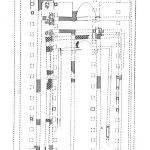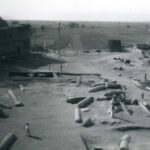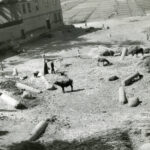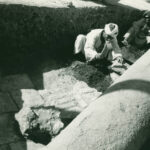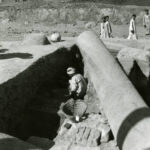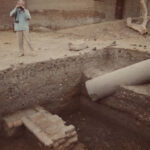FĀW AL-QIBLĪ (PBOOU)
| Greek | Βοπος |
| Coptic | pbau | pboou | pbwou | vboou | vbwou |
| Arabic | فاو القبلي |
| English | Pbou | Pbaw | Bau | Bopos |
| French | Fao Qibli | Faou el-Qibli | Fâou el-Qibli |
| DEChriM ID | 38 |
| Trismegistos GeoID | 3843 |
| Pleiades ID | 756540 | PAThs ID | 68 |
| Ancient name | Pboou |
| Modern name | Fāw al-Qiblī |
| Latitude | 26.1125346 |
| Longitude | 32.4029556 |
| Date from | - |
| Date to | - |
| Typology | Monastic settlement |
| Dating criteria | - |
| Description | Fāw al-Qiblī, ancient Pboou, is home to a monastic complex supposedly founded by Pachomius during his lifetime, and is thus one of the most important cenobitic monasteries of early Christianity (Grossmann 1991: 1928; id 2002: 547; 550). The site, situated on the outskirts of Fāw al-Qiblī, comprises the ruins of the monastery-basilica complex which includes a number of housing structures, hydraulic installations and industrial equipment (Debono 1971: 210-220; Ghica 2019: 129). Unfortunately, almost all of the archaeological work conducted at the site (apart from that of Debono) focused exclusively on the basilica, meaning very little is known about these additional structures, most of which have since been destroyed by agricultural development. Although the church and associated complex are not mentioned in Pachomian sources, their existence is implied in the Greek Vita prima (Halkin 1932: 56; Grossmann 2002: 548, n. 528; Ghica 2019: 130). The chronological development of the structure is not entirely clear, with interpretations differing between the excavation teams. Debono, who first excavated in the late 60s, believed that the terminus post quem for the basilical remains that can be seen today was 381, given the discovery of a Pharaonic inscription which had been reused as a pillar base, an act which must have occurred after Theodosius’ official abolition of ‘paganism’ (Van Elderen and Robinson 1977a: 66). This does not provide any clarification concerning the relative chronology of the earlier structures, however. The team who excavated in the 70s as part of the ‘Nag Hammadi Excavations’ determined that the large five-aisled basilica, the most discernable structure on the site, was built atop of an earlier church structure, which was itself constructed atop an even earlier building (Van Elderen 1979: 227). The two seasons of excavation led to the identification of five building phases at the site, each of which were dated based on associated ceramic. These dates were additionally supported by a number of coins found during the first archaeological mission, including mints of Constance II, Valens or Valentinian and Theodosius (Debono 1971: 218, pl. LIX). Phase I comprises a large third century building, the remains of which were found scattered throughout parts of the site, though not in the area of the basilica itself. These and other remnants, including a considerable amount of ceramic, intact and fragmented, dating from the first century, indicate the presence of a large Roman settlement at the site. Phase II consists of a structure which included a room containing many large storage vessels dating from the late third to early fourth century. Phase III corresponds to the earliest church, built atop of the structure from Phase II. This church is understood to date from the fourth-fifth centuries, with various ceramic supporting the fourth century date (Van Elderen and Robinson 1977a: 62, 65). Phase IV comprises the large basilica, which is understood to have been constructed in the fifth century, being abandoned in the seventh or perhaps eighth century. A destruction layer was also identified, corroborating with the 11th century destruction of the basilica attributed to al-Ḥākim (Van Elderen 1979: 228; Ṣālih 1895: 282). Phase V, the final one, which was only identified at a single area of the site, comprises the remains of an Islamic building dating from the 11th to 12th centuries (Van Elderen 1979: 228-231). Grossmann, who conducted excavations in the 1980s alongside G. Lease, considered that there were indeed three successive building phases, but that each of these were church structures, meaning there were two churches situated underneath the current basilical remains, giving a total of three successive churches (Lease 1991; Grossmann 1991; Ghica 2019: 129). The oldest structure, denoted ‘the “first” building’, is considered to date from the first half of the fourth century based on ceramic, with a hypothesised terminus post quem of 336-337, when Pachome founded the monastery of Pbow (Grossmann and Lease 1990: 11; Grossmann 2002: 23-24, 547; Ghica 2019: 129). This earliest phase was only partially discernible, with a few sections of the north and eastern walls being visible, but the identification of the northern half of the apse confirmed that it was indeed a church (Grossmann and Lease 1990: 9; Grossmann 1991: 1928b; Ghica 2019: 129). This earliest church belongs to Robinson’s Phase II, mentioned above, with the storage room containing the above-mentioned storage jars believed to have been constructed when this first church was already in use (Grossmann and Lease 1990: 11). This was then followed by the construction of an ‘intermediate’ church structure. Though considered by Grossman to be the most difficult to date with certainty, this structure can be broadly situated at the end of the fourth/beginning of the fifth century (Ghica 2019: 129). Perhaps half a century later, the third structure was built, that is ‘the “great” basilica’, with the column shafts which covered the ground belonging to this phase (though originating from earlier Roman period buildings) (Grossmann and Lease 1990: 9; Grossmann 1991: 1928b). The “great” basilica is understood to date from 459, given that that is the date of a sermon given by Timotheus of Alexandria at the consecration of a new church (Grossmann and Lease 1990: 10, n. 3). These later excavations revealed that the church included a large quantity of burials, with these individuals seemingly interred both when the church was in operation, and after the cessation of official worship (Grossmann 1979: 234). Grossmann and Lease reject the destruction of the structure by al-Ḥākim, and instead suppose that after reaching its peak in the fifth century, the church slowly began to decline and was simply abandoned in the sixth century (Grossmann and Lease 1990: 13). |
| Archaeological research | One of the earliest known mentions of the site is from the 12th century by Yāqūt al-Hamawī (Ṣālih 1895: 280-282). However, it was not until the beginning of the 20th century that additional information was written about the site, authored by M. Julien in 1901 and 1903. This was then followed by descriptions from L. Massignon in 1911 and L. Lefort in 1939. The first archaeological fieldwork was not conducted until 1968, when the Pontifical Institute of Christian Archaeology instigated a 25-day season of fieldwork, under the patronage of the Jesuit priest Henry Habib Ayrout (Debono 1971: 191-220). Fieldwork began 10th January 1968 under the direction of F. Debono, ending on February 5th. This was followed by a further six seasons of work, conducted by two independent missions. The first two seasons were conducted by what was an essentially American team led by J. M. Robinson. After fieldwork commenced at the Ǧabal al-Ṭārif in 1975 in an attempt to clarify the context of the Naǧʿ Ḥammādī codices, excavations were initiated at the monastery-basilica complex in 1976 by the same team. Excavations were initiated due to the relative spatial (and temporal) proximity of the monastery complex, situated some 18km north-east of the Ǧabal al-Ṭārif and thus seen as a possible origin of the Naǧʿ Ḥammādī codices. The first season of work here, considered the second season of the ‘Nag Hammadi Excavation’, was conducted 22nd Nov. – 29th Dec. 1976, while the second season was 24th Dec. 1977 – 25th Jan 1978. Like the work at the Ǧabal al-Ṭārif in 1975, the fieldwork was directed by Bastiaan Van Elderen. This was followed by four seasons of work in the 1980s, conducted with the intention of clarifying information obtained during Robinson’s excavations. These missions were directed by P. Grossmann and G. Lease. The most recent archaeological work carried out at Fāw al-Qiblī was the final season of this mission, conducted in 1989. |
• Amélineau, E. 1890. La géographie de l’Égypte à l’époque copte. 331-333. Paris: Imprimerie Nationale.
• Debono, F. 1971. “La basilique et le monastère de St. Pachôme. (Fouilles de l’Institut Pontifical d’Archéologie Chrétienne, à Faou-el-Qibli, Haute Égypte – janvier 1968.” Bulletin de l’Institut français d’archéologie orientale 70: 191-220.
• Elderen, B. van. 1979. “The Nag Hammadi Excavation.” Biblical Archaeology 42: 225-231.
• Gauthier, H. 1905. “Notes géographiques sur le nome panopolite.” Bulletin de l’Institut français d’archéologie orientale 4: 39-101.
• Ghica, V. 2016. “Vecteurs de la christianisation de l’Égypte au IVe siècle à la lumière des sources archéologiques.” In Acta XVI Congressus Internationalis Archaeologiae Christianae, Rome 22-28.9.2013, edited by Olof Brandt and Gabriele Castiglia, 248 and 250. Città del Vaticano: Pontificio Istituto di Archeologia Cristiana.
• Ghica, V. 2019. “L’archéologie du monachisme égyptien au IVe siècle: État de la question.” In Nag Hammadi à 70 ans, qu’avons-nous appris? Nag Hammadi at 70: What Have We Learned? Colloque international, Québec, Université Laval, 29-31 mai 2015, edited by Eric Crégheur, Louis Painchaud and Tuomas Rasimus, 129-131. Leuven-Paris-Bristol: Peeters.
• Grossmann, P. 1979. “The Basilica of St. Pachomius.” The Biblical Archaeologist 42/4: 232-236.
• Grossmann, P. 1991. “Pbow. Archaeology.” In The Coptic Encyclopedia, vol. 6, edited by A. S. Atiya, 1927b-1929a. New York: Macmillan.
• Grossmann, P. 1981. “Esempi d’architettura paleocristiani in Egitto dal V al VII secolo.” Corsi Ravenna 28: 151-153.
• Grossmann, P. 2001. “Faw Qibli. Excavation in the Year 1986.” Annales du Service des antiquités de l’Égypte 76: 143-148.
• Grossmann, P. 2002. Christliche Architektur in Ägypten, 546-551. Leiden: Brill.
• Grossmann, P. and G. Lease. 1990. “Faw Qibli – 1989 Excavation Report.” Göttinger Miszellen 114: 9-12.
• Halkin, F. 1932. Sancti Pachomii Vitae graecae. Brussels: Société des Bollandistes.
• Jullien, M. 1901. “A la recherche de Tabenne et des autres monastères fondés par Saint Pacôme.” Études 89: 230-258.
• Lease, G. 1991. Traces of Early Egyptian Monasticism: The Faw Qibli Excavations. Claremont, CA: Institute for Antiquity and Christianity.
• Leclerq, H. 1910. “Cénobitisme.” In Dictionnaire d’archéologie chrétienne et de liturgie, edited by F. Cabrol and H. Leclercq, vol. 2, col. 3047-3248. Paris: Letouzey et Ané.
• Leclerq, H. 1938. “Peboou.” In Dictionnaire d’archéologie chrétienne et de liturgie, edited by F. Cabrol and H. Leclercq, vol. 13, col. 2874-2875. Paris: Letouzey et Ané.
• Lefort, L. Th. 1939. “Les premiers monastères pachômiens. Exploration topographique.” Le Muséon 52: 379-407.
• Massignon, L. 1911. “Seconde note sur l’état d’avancement des études archéologiques arabes en Égypte.” Bulletin de l’Institut français d’archéologie orientale 9: 83-89.
• Evetts, B. T. A. 1895. The Churches and Monasteries of Egypt and Some Neighbouring Countries. Oxford: Clarendon Press.
• Timm, S. ed. 1984-1992. Das christliche-koptische Ägypten in arabischer Zeit: eine Sammlung christicher Stätten in Ägypten in arabischer Zeit unter Ausschluss von Alexandria, Kairo, des Apa-Mena-Klosters (Dēr Abū Mina), der Skētis (Wādi n-Naṭrūn) und der Sinai-Region. Vol. 2, 947-957. Weisbaden: Dr Ludwig Reichert.
• Van Elderen, B., and J. M. Robinson. 1977a. “The Second Season of the Nag Hammadi Excavation 22 November-29 December 1976.” Göttingen Miszellen 24: 57-73.
• Van Elderen, B., and J. M. Robinson. 1977b. “The Second Season of the Nag Hammadi Excavation 22 November-29 December 1976.” American Research Center in Egypt Newsletter 99/100: 36-54.
• Wilkinson, G. Modern Egypt and Thebes, II, p. 118. London: John Murray.


 Json data
Json data